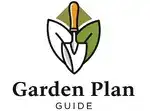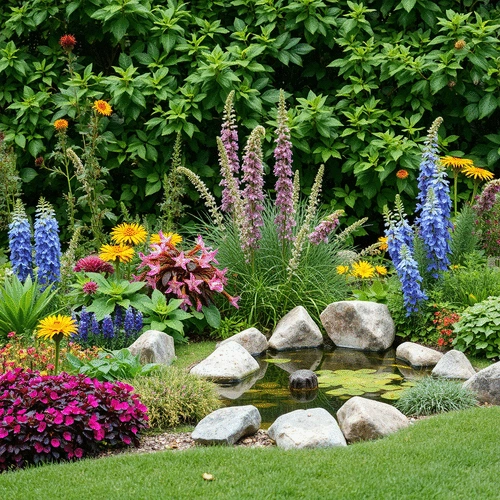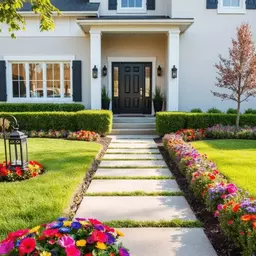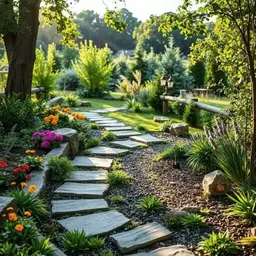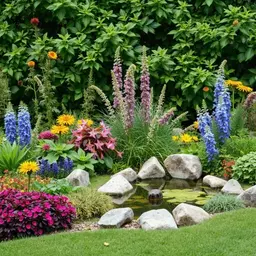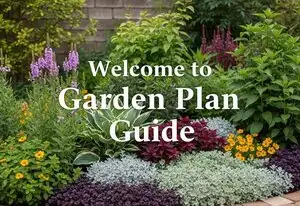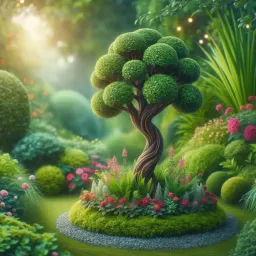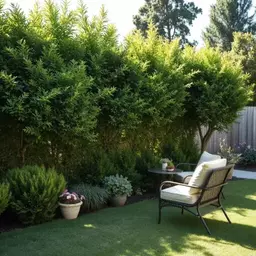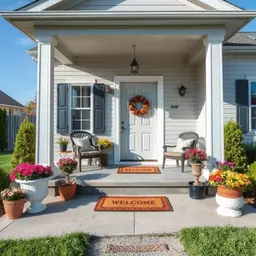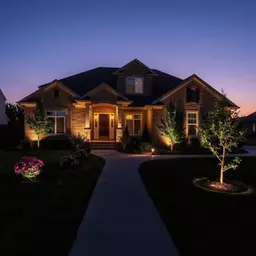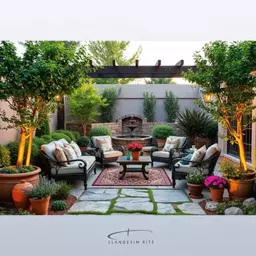As we navigate the challenges of modern gardening, the importance of local ecosystems becomes more apparent. Understanding the role of native plants in sustainable landscaping is not just beneficial for our gardens but essential for the environment. This article uncovers the transformative power of native plants and how they can help us create lush, sustainable landscapes.
What You Will Learn
- Native plants are adapted to local climates and require less water and maintenance, making them highly sustainable choices for landscaping.
- Incorporating native plants into your garden fosters biodiversity by supporting local wildlife, including pollinators like bees and butterflies.
- Choosing native plants can lead to cost savings over time due to their drought-resistance and lower maintenance needs.
- Managing invasive species is crucial for maintaining a healthy garden environment; staying informed and proactive can make a significant difference.
- Local resources such as nurseries and native plant societies provide valuable knowledge and support for sustainable gardening practices.
- Engaging in community initiatives and creating pollinator gardens can enhance local biodiversity and inspire collective efforts towards sustainability.
Key Advantages of Native Plants in Sustainable Landscaping
Native plants offer various ecological benefits that contribute to sustainable landscaping. Below is a comparison of their key advantages.
Water Efficiency
Native plants are drought-resistant, making them ideal for regions with limited rainfall. Their adaptability allows them to thrive without excessive irrigation.
Cost-Effectiveness
Once established, native plants require minimal maintenance and irrigation, significantly reducing garden upkeep costs over time.
Wildlife Support
By planting native species, you contribute to local ecosystems, providing necessary food and habitat for pollinators and other wildlife.
Soil Health
Native plants improve soil quality by promoting healthy microbial activity, which in turn enhances nutrient availability and supports other plants.
Understanding Native Plants and Sustainable Landscaping
As someone who has spent years nurturing my garden, I can tell you that understanding native plants is a game changer for anyone looking to create a sustainable landscape. Native plants are those that have evolved in a specific region over time, adapting to the local climate and soil conditions. This makes them incredibly resilient and well-suited for sustainable landscaping, as they require less water, fewer chemicals, and minimal maintenance once established. By choosing native species, we can help our gardens flourish while also benefiting the environment!
So, what’s the role of these native plants in sustainability? They play a crucial part in maintaining local ecosystems. By planting them in your garden, you're not just creating a beautiful space, but you're also fostering a habitat for wildlife, promoting biodiversity, and ensuring that our landscapes remain vibrant and healthy for generations to come.
Defining Native Plants and Their Role in Sustainability
When we talk about native plants, we refer to species that naturally occur in a specific area without human introduction. These plants thrive in their native environment and support local wildlife. They contribute to sustainability by maintaining ecological balance and providing food and shelter for native animals. It's like inviting your neighbors over for a backyard party—everyone benefits!
To illustrate, here are some key aspects of native plants and their role in sustainability:
- Adaptability: Native plants are adapted to local soils and climates, requiring less water and care.
- Biodiversity: They promote a diverse ecosystem, supporting various species including birds, insects, and mammals.
- Soil Health: Native plants improve soil quality by promoting healthy microbial activity.
Why Choose Native Plants for Your Landscape?
Choosing native plants for your landscape is like opting for a locally-sourced meal—you're supporting your community and the environment! Native plants require less maintenance than non-native species, which can save you time and effort in the long run. Plus, they are more resistant to local pests and diseases, meaning you can reduce your reliance on harmful chemicals.
Here are some benefits of selecting native plants for your landscape:
- Water Efficiency: Native plants are drought-resistant, making them perfect for areas with less rainfall.
- Cost-Effective: Once established, they require minimal irrigation and maintenance.
- Wildlife Support: They help maintain the local ecosystem by supporting pollinators like bees and butterflies.
At Garden Plan Guide, I believe that embracing native plants not only enhances the beauty of your garden but also contributes to a greater cause—our planet's health! So let’s get our hands dirty and explore how we can create stunning, sustainable landscapes together. For more ideas on how to improve your garden's aesthetic, you might explore plants that boost curb appeal.
Ecological Benefits of Native Plants in Landscaping
Native plants are a powerful tool in promoting a healthy ecosystem. When we incorporate them into our landscapes, we're not just beautifying our outdoor spaces; we’re playing a vital role in supporting local wildlife and enhancing the environment.
In the upcoming sections, I'll delve deeper into the ecological benefits, examining how these plants help promote biodiversity and enhance soil health. Let’s discover how they make a positive impact on our surroundings!
Interactive Poll: Your Thoughts on Native Plants!
We want to know your perspective on incorporating native plants into landscaping! How do you feel about using native plants in your garden?
Addressing Common Concerns with Native Plant Landscaping
As we embrace the idea of using native plants in our gardens, it's natural to have some concerns! One common worry is about invasive species that might threaten our carefully curated landscapes. Understanding what these species are and how to manage them is crucial for maintaining a healthy garden environment.
Invasive plants can outcompete native flora, disrupting local ecosystems. Here are a few tips to manage invasives:
- Identify known invasive species in your area.
- Regularly monitor your garden for unwanted plants.
- Remove invasive plants promptly to prevent spreading.
Remember, not all plants labeled as invasive are bad; some can be contained or managed effectively. The key is to stay informed and proactive to support your beautiful native garden!
Cautions About Invasive Species and Their Management
When it comes to managing invasive species, knowledge is power. I recommend connecting with local gardening groups or extension services for resources specific to your area. They can provide valuable insights into which plants to watch out for and effective management practices that have been successful in similar gardens.
Additionally, keep in mind:
- Educate yourself about the native plants that thrive in your region.
- Choose native plants that are well-suited to your garden's conditions.
- Stay engaged with local conservation efforts to learn best practices.
By being aware and taking action, we can help ensure our gardens remain vibrant and supportive of local ecosystems.
Maintenance Tips and Troubleshooting Common Issues
Once you’ve planted your native garden, you may encounter some common maintenance challenges. But don't worry; I've got some tips to help you keep everything thriving! Native plants are often more resilient and require less care than non-native varieties.
Here are some maintenance tips I’ve found to be helpful:
- Water your garden deeply but infrequently to encourage deep root growth.
- Mulch around plants to retain moisture and suppress weeds.
- Regularly check for pests and diseases, and address them early.
By following these tips, you can minimize problems and enjoy the beauty of your native landscape with ease! You might also find it helpful to explore simple patio landscaping ideas to integrate your native garden into other outdoor spaces.
FAQs About Native Plants and Sustainable Landscaping
Q: What are native plants?
A: Native plants are species that have evolved in a specific region over time, adapting to the local climate and soil conditions without human introduction. This makes them resilient and well-suited for sustainable landscaping.
Q: Why should I choose native plants for my garden?
A: Native plants offer numerous benefits, including requiring less water and maintenance, supporting local wildlife and biodiversity, improving soil health, and being more resistant to local pests and diseases.
Q: How do native plants contribute to sustainability?
A: They contribute by maintaining ecological balance, fostering habitats for wildlife, reducing the need for irrigation and chemical treatments, and promoting a diverse ecosystem.
Q: What are invasive species, and how do I manage them?
A: Invasive species are non-native plants that can outcompete native flora and disrupt local ecosystems. Management involves identifying known invasive species, regularly monitoring your garden, and promptly removing unwanted plants.
Q: Where can I find resources for native plant selection and purchase?
A: You can connect with local nurseries specializing in native plants, join community workshops, check online resources focusing on native plant education, and participate in local native plant societies or botanical gardens.
Encouraging Sustainable Landscaping Practices
Now that we’ve covered some of the concerns and maintenance tips, let’s explore how we can promote sustainable landscaping practices in our communities. After all, it's about creating a movement towards eco-friendly gardening that benefits everyone!
First, it’s essential to connect with local resources for native plant selection and purchase. Here are some options to consider:
- Visit local nurseries that specialize in native plants.
- Join community workshops on sustainable landscaping.
- Check out online resources that focus on native plant education.
By supporting local businesses like those featured on Garden Plan Guide, we can ensure that we’re using the best plants for our environment!
Local Resources for Native Plant Selection and Purchase
Connecting with native plant societies and nurseries can provide you with a wealth of knowledge and hands-on experience. These organizations often host plant sales, educational workshops, and volunteer opportunities that can deepen your understanding of native gardening.
Some great places to look into are:
- Your local native plant society.
- Botanical gardens that focus on regional flora.
- Native plant sales held by environmental groups.
Getting involved in these communities can enhance your gardening journey and allow you to share your experiences with others!
Connecting with Native Plant Societies and Nurseries
Joining a native plant society can be an excellent way to expand your network and gain access to exclusive resources. Many of these groups offer:
- Workshops on native plant care and maintenance.
- Group outings to observe local ecosystems.
- Discounts at local nurseries for members.
It’s a fantastic opportunity to learn and connect with like-minded individuals who share your passion for sustainable gardening!
Getting Involved in Community Native Plant Initiatives
Lastly, consider getting involved in community native plant initiatives. These efforts can range from creating pollinator gardens to participating in community garden projects. Not only do these initiatives beautify your neighborhood, but they also contribute to local biodiversity!
Here’s how you can get involved:
- Volunteer for local landscaping projects focused on native plants.
- Organize community planting days to encourage participation.
- Share your knowledge through workshops or presentations.
Your involvement can inspire others to embrace sustainable landscaping practices, fostering a collective effort towards a greener future! For more ideas on how to integrate plants into your landscaping, consider enhancing curb appeal with trees.
Creating Pollinator Gardens and Community Gardens
Creating dedicated pollinator gardens is a rewarding way to support local wildlife. These gardens can be small or large and typically feature:
- A variety of native flowering plants to attract pollinators.
- Nesting sites like bee hotels or sandy patches for ground-nesting bees.
- Mulched areas for butterflies to rest and hide from predators.
Community gardens can also serve as a platform for education and collaboration, allowing people to share their gardening tips and experiences! To further enhance your garden's appeal, exploring designing a welcoming home entrance can provide valuable insights.
Final Thoughts on Embracing Native Plants for Sustainability
As we wrap up our journey through the world of native plants, it’s clear that these incredible species play a vital role in creating sustainable landscapes. By choosing native plants, we not only benefit our gardens but also contribute to the health of our local ecosystems.
Encouraging your community to adopt native landscaping practices can lead to a more vibrant and resilient environment for all. Start conversations with your friends and neighbors about the importance of native plants and how they can transform their gardens!
Encouraging Your Community to Adopt Native Landscaping
Share your gardening stories and successes with others! Whether through social media, community newsletters, or local events, spreading the word about the benefits of native plants can help shift perspectives and inspire action. I’d love to hear how you’re making a difference in your community!
Call to Action: Start Your Native Plant Journey Today
So, what are you waiting for? Let's embark on this exciting journey toward sustainable gardening together! Visit Garden Plan Guide for resources, tips, and inspiration, and start planning your native plant garden today. Every small step counts!
Recap of Key Points
Here is a quick recap of the important points discussed in the article:
- Understanding Native Plants: Native plants are adapted to local environments and require less water and maintenance.
- Benefits of Native Landscaping: Choosing native plants supports local wildlife, promotes biodiversity, and enhances soil health.
- Water Efficiency and Cost-Effectiveness: Native plants are drought-resistant and reduce the need for irrigation and chemical treatments.
- Managing Invasive Species: Stay informed about local invasive species and remove them promptly to protect native flora.
- Community Engagement: Connect with local resources, participate in native plant initiatives, and share your experiences to promote sustainable landscaping practices.
